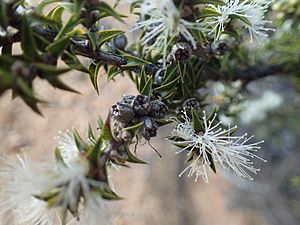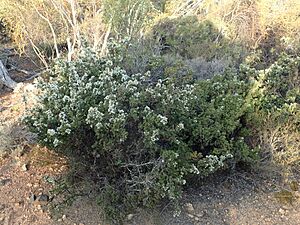Melaleuca cliffortioides facts for kids
Quick facts for kids Melaleuca cliffortioides |
|
|---|---|
 |
|
| Melaleuca cliffortioides foliage, flowers and fruit | |
| Scientific classification | |
| Genus: |
Melaleuca
|
| Species: |
cliffortioides
|
Melaleuca cliffortioides is a special plant that belongs to the myrtle family. It grows only in the southwest part of Western Australia. This plant is a small, spiky shrub. It looks a lot like another plant called Melaleuca podiocarpa, but its flowers have fewer stamens.
Contents
What Does This Plant Look Like?
Melaleuca cliffortioides can grow up to about 1.6 meters (5 feet) tall. Its small branches are covered with soft, fine hairs. The leaves are arranged one after another along the stem. They are about 4 to 9 millimeters long and 1.6 to 2.5 millimeters wide. The leaves are narrow and oval-shaped, coming to a sharp point. They also have many tiny oil glands that you can easily see.

This plant produces many flowers, but they grow hidden within the leaves. The flowers are white or cream-colored and smell sweet. Their petals are about 2.2 to 2.8 millimeters long. These petals fall off as the flower opens up. Inside the flower, there are five groups of stamens (the parts that make pollen). Each group has 8 to 13 stamens. For comparison, Melaleuca podiocarpa has 30 to 45 stamens per group!
The main time for flowering is in September. After the flowers, the plant grows woody seed pods called capsules. These capsules are about 4 to 5 millimeters long.
How Did This Plant Get Its Name?
The plant Melaleuca cliffortioides was first officially described in 1905. This was done by a scientist named Ludwig Diels. He wrote about it in a scientific book.
The second part of its name, cliffortioides, describes what it looks like. It means "resembling Cliffortia". The ending -oides is a Latin word part that means "looking like" or "having the shape of".
Where Does This Plant Grow?
This type of melaleuca plant is found in several areas of Western Australia. You can see it from the Ravensthorpe area all the way to the Norseman area. It grows in sandy soil on rocky hillsides. It also likes to grow on flat or gently rolling plains.
Is This Plant Safe?
The government of Western Australia's Department of Parks and Wildlife has looked at this plant. They have classified it as "not threatened." This means it is not currently in danger of disappearing.

